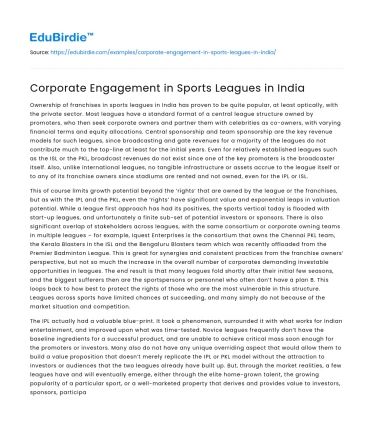Ownership of franchises in sports leagues in India has proven to be quite popular, at least optically, with the private sector. Most leagues have a standard format of a central league structure owned by promoters, who then seek corporate owners and partner them with celebrities as co-owners, with varying financial terms and equity allocations. Central sponsorship and team sponsorship are the key revenue models for such leagues, since broadcasting and gate revenues for a majority of the leagues do not contribute much to the top-line at least for the initial years. Even for relatively established leagues such as the ISL or the PKL, broadcast revenues do not exist since one of the key promoters is the broadcaster itself. Also, unlike international leagues, no tangible infrastructure or assets accrue to the league itself or to any of its franchise owners since stadiums are rented and not owned, even for the IPL or ISL.
This of course limits growth potential beyond the ‘rights’ that are owned by the league or the franchises, but as with the IPL and the PKL, even the ‘rights’ have significant value and exponential leaps in valuation potential. While a league first approach has had its positives, the sports vertical today is flooded with start-up leagues, and unfortunately a finite sub-set of potential investors or sponsors. There is also significant overlap of stakeholders across leagues, with the same consortium or corporate owning teams in multiple leagues – for example, Iquest Enterprises is the consortium that owns the Chennai PKL team, the Kerala Blasters in the ISL and the Bengaluru Blasters team which was recently offloaded from the Premier Badminton League. This is great for synergies and consistent practices from the franchise owners’ perspective, but not so much the increase in the overall number of corporates demanding investable opportunities in leagues. The end result is that many leagues fold shortly after their initial few seasons, and the biggest sufferers then are the sportspersons or personnel who often don’t have a plan B. This loops back to how best to protect the rights of those who are the most vulnerable in this structure. Leagues across sports have limited chances at succeeding, and many simply do not because of the market situation and competition.
Save your time!
We can take care of your essay
- Proper editing and formatting
- Free revision, title page, and bibliography
- Flexible prices and money-back guarantee
The IPL actually had a valuable blue-print. It took a phenomenon, surrounded it with what works for Indian entertainment, and improved upon what was time-tested. Novice leagues frequently don’t have the baseline ingredients for a successful product, and are unable to achieve critical mass soon enough for the promoters or investors. Many also do not have any unique overriding aspect that would allow them to build a value proposition that doesn’t merely replicate the IPL or PKL model without the attraction to investors or audiences that the two leagues already have built up. But, through the market realities, a few leagues have and will eventually emerge, either through the elite home-grown talent, the growing popularity of a particular sport, or a well-marketed property that derives and provides value to investors, sponsors, participants, and critically, the audiences.
Did you like this example?
Make sure you submit a unique essay
Our writers will provide you with an essay sample written from scratch: any topic, any deadline, any instructions.
Cite this paper
-
APA
-
MLA
-
Harvard
-
Vancouver
Corporate Engagement in Sports Leagues in India.
(2022, September 15). Edubirdie. Retrieved December 22, 2024, from https://edubirdie.com/examples/corporate-engagement-in-sports-leagues-in-india/
“Corporate Engagement in Sports Leagues in India.” Edubirdie, 15 Sept. 2022, edubirdie.com/examples/corporate-engagement-in-sports-leagues-in-india/
Corporate Engagement in Sports Leagues in India. [online].
Available at: <https://edubirdie.com/examples/corporate-engagement-in-sports-leagues-in-india/> [Accessed 22 Dec. 2024].
Corporate Engagement in Sports Leagues in India [Internet]. Edubirdie.
2022 Sept 15 [cited 2024 Dec 22].
Available from: https://edubirdie.com/examples/corporate-engagement-in-sports-leagues-in-india/
copy






 Stuck on your essay?
Stuck on your essay?

